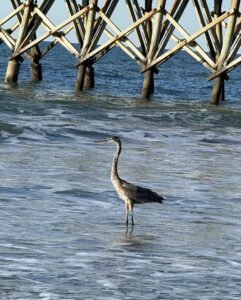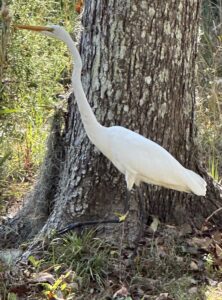Great Egret, Snowy Egret, and Tricolored Heron
As I wrote in my previous blogs, it was not the best birding from the beaches and shorelines around Charleston, SC, but we did see these three birds. The Great Egret is one of the birds that is pushing its range northward a bit. We now have more of them here in central Illinois in summer. When we first moved here about 20 years ago, it was rare to see them in the ponds close to our house. Now they are more common. Instead of one or none, now there are two or three. We even have one or two on our small lake off and on during the summer months.

I always like to compare birds – I find this especially helpful when I see a bird I do not recognize. When I first started birding, herons and egrets were birds I knew nothing about. I was exploring Chincoteague National Wildlife Refuge in Virginia and there I saw Great Egrets and Great Blue Herons fairly close to each other. My first impression was: “Wow! Those birds are tall!”
The Great Blue Heron stands about 52-55 inches tall. The Great Egret is about 40 inches tall.
The Great Blue Heron weighs about 6.5 pounds and the Great Egret weighs 2 pounds.
The heron’s wingspan is about 6 feet and the egret’s is about 4.5 feet.
When these birds are fairly close together, the heron is obviously a bigger bird. And of course, their colorings are quite different. But take a good look at how they hold their necks. In flight and when at rest standing on the ground – often dozing – both retract their necks into an ‘S’ shape. (Note: In flight, this is a good way to tell herons and egrets apart from storks, cranes, and ibises who fly with necks outstretched – not retracted into an ‘S’ shape.) It is when herons and egrets are standing still that there can be slight differences in how they hold their necks. The heron tends to stand with its neck more straight or slightly curved. The egret often stands with its neck bent rather oddly. Not curved, but more angular – like a slight kink. These birds share part of their ranges – most notably along the Atlantic and Gulf coasts and in our southern states. When these birds are together in an area, you can compare.



A relative of the Great Egret is the Snowy Egret. The Snowy is similar in coloring and posture to the Great Egret, but when they are side by side, you can see the differences. The Snowy is obviously a smaller bird:
About 24 inches tall.
Weighs about 12 ounces.
A wingspan of about 3 feet.
Instead of a yellow beak as the Great Egret has, the Snowy’s beak is black. Both have long black legs, but where there is a startling difference is their feet. The Great Egret has black feet and toes – the Snowy Egret has golden feet and toes. Hence its great nickname – Cinderella Toes!
These two egrets also forage very differently. The Great Egret forages in a similar way to the Great Blue Heron – both often stand still and then quickly grab something from the water. Or they will walk – rather stately! – through shallow water, and grab anything they see.

Snowy Egrets are different. No standing and waiting for prey to come to them. No stately walking through shallow water grabbing anything that moves. They dance! You will see them in shallow water, moving/racing back and forth over a small area. And they will move their wings while prancing. This churns up water. The movement of the water and also the flashing of those golden toes startles prey, the prey moves, and the egrets snatches it. These birds are fun to watch! I have included a video of a Great Egret and a Snowy Egret from the Cooper River County Park and Marina. You will be able to compare their size, how they hold themselves, and how they move. I suggest that you keep your volume turned down as it was a windy day. Click here: Great Egret and Snowy Egret
At this same marina, we saw a Tricolored Heron – truly a coastal bird of the Atlantic and Gulf. Except in the states of Florida and Louisiana, you will rarely see this bird far from either coastline. This bird has had a name change – sadly, in my opinion. It was formerly known as the Louisianna Heron which immediately conjures up images of mysterious, misty bayous where it is very much at home. Tricolored Heron. Such a bland name. But there it is.

The Tricolored is close in size to the Snowy and as you can see in the video below, it is also graceful and light on its feet. It does not dance as well as the Snowy, but it will move back and forth in the water with jerky movements in order to scare up something tasty. As the video goes on, you will notice its legs and feet are on the dull olive side – no flashy toes. But towards the end of the video, you will get an idea of its feet – and they are rather big. Click here to watch the video: Tricolored Heron
Great Blue Herons and especially Great Egrets and Snowy Egrets are often not alone. They are not actually in flocks – they will act as individuals – but several to many of their species will be close by. The Tricolored Heron can be with others of its species, but is more often alone, or just with one or two Tricoloreds within in sight. However, this heron will often be with other herons and egrets.
I do not often get to observe a Tricolored Heron, so this was a real treat for me. Not a flashy bird at all, but when you get a good look at one through your binoculars or scope, it is a real beauty!

